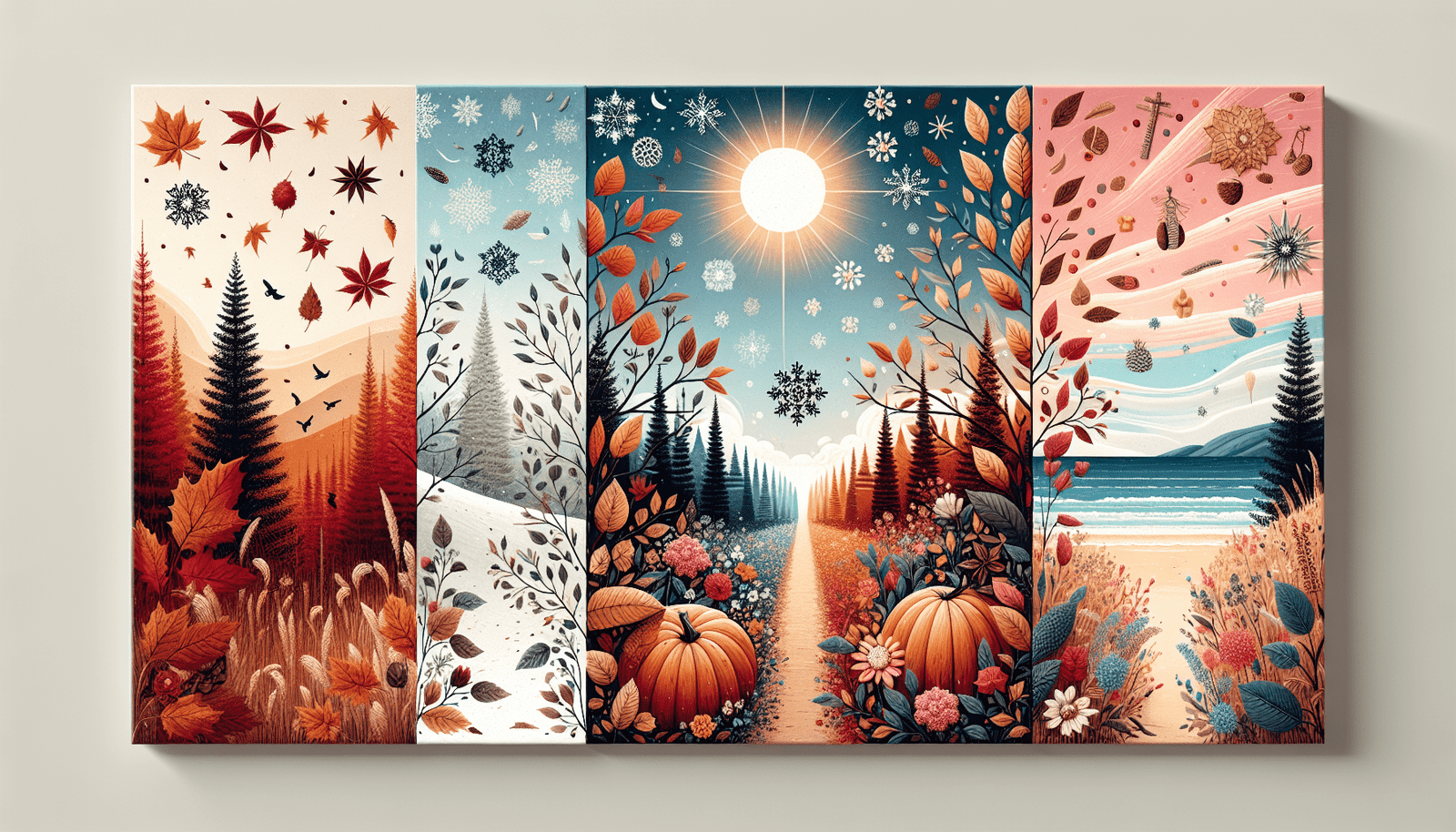Welcome to your guide on spotting and utilizing seasonal trends to create stunning book covers that grab attention. In this article, you’ll discover how to recognize the ebb and flow of design trends throughout the year and use them to your advantage. From color palettes that embody the spirit of the season to popular motifs and themes that resonate with readers, you’ll learn the keys to crafting covers that not only catch the eye but also captivate the imagination. Dive in and find out how you can harness the power of seasonal trends to make your book stand out on the shelves!
Have you ever wondered how you can make your book covers stand out by utilizing seasonal trends? In today’s ever-evolving market, capitalizing on seasonal themes can be your golden ticket to creating visually appealing book covers that captivate audiences. Whether you’re a seasoned author or just starting out, identifying and leveraging these trends can significantly impact your book’s success.
Understanding Seasonal Trends
Seasonal trends are those recurring themes and motifs that resonate with people during particular times of the year. Think about holiday decorations, fashion trends, or even the type of food people crave during specific seasons. For book covers, tapping into these trends can make your work more relatable and enticing.
What Are Seasonal Trends?
Seasonal trends refer to patterns in consumer behavior and preferences that change according to the time of year. These trends can be influenced by a variety of factors such as weather, holidays, cultural events, and even seasonal colors. For instance, during fall, you might see a spike in themes related to Halloween or autumn foliage.
Why Do Seasonal Trends Matter?
Seasonal trends matter because they can affect the marketability of your book. Being attuned to these trends can help you create a cover that not only aligns with current consumer interests but also stands out on the shelf. This can ultimately result in higher sales and greater reader engagement.
By understanding and leveraging these trends, you provide potential readers with visual cues that can evoke emotions or memories, making them more likely to pick up your book.
Identifying Seasonal Trends
Before you can leverage seasonal trends, you need to know how to identify them. This involves research, observation, and staying updated with market dynamics.
Research Popular Trends
Begin by researching popular trends in various industries such as fashion, home decor, and even food. These sectors often set the tone for what’s trending during a particular season.
Tools for Trend Research
- Google Trends: Provides insights into what people are searching for during different times of the year.
- Social Media Platforms: Websites like Instagram, Pinterest, and Twitter can offer a wealth of information on current trends.
- Industry Blogs and Magazines: These can give you a snapshot of upcoming trends, complete with expert opinions and analyses.
Monitor Competitors
Keeping an eye on your competitors can offer valuable insights into what works and what doesn’t. Look at the covers of books in your genre that were released during the same season in previous years.
Engage with Your Audience
Sometimes the best insights come directly from your audience. Engage with your readers through social media polls or newsletter surveys to understand what themes and motifs resonate with them during different seasons.
Leveraging Seasonal Trends for Your Book Cover
Now that you’ve identified the trends, it’s time to leverage them effectively. Here are some ways to do that:
Choose Seasonal Colors
Color plays a critical role in setting the tone and mood of your book cover. Different seasons have different color palettes that you can use to make your cover more appealing.
| Season | Color Palette |
|---|---|
| Spring | Pastels like pink, mint green, and baby blue |
| Summer | Bright colors like yellow, turquoise, and coral |
| Fall | Earth tones like orange, brown, and deep reds |
| Winter | Cool colors like blue, silver, and white |
Incorporate Seasonal Elements
Including seasonal elements such as snowflakes for winter, flowers for spring, or leaves for fall can also make your book cover stand out. These elements not only make the cover visually appealing but also evoke the essence of the season.
Seasonal Typography
The type of fonts you choose can also reflect seasonal trends. For example, whimsical and playful fonts can evoke a spring or summer feel, while serif fonts can lend a cozy, wintery vibe to your cover.
Thematic Imagery
Consider using imagery that ties into seasonal activities or holidays. For instance, a romance novel set in winter can feature a snowy landscape, while a summer thriller might have a beach scene.
Trend Confirmation
Always double-check your research and see if the trend you’re planning to use is gaining traction. Use multiple sources to confirm that the trend is widespread and not just a fleeting fad.
Testing Your Seasonal Concepts
Once you have your seasonal elements in place, it’s crucial to test them to see if they resonate with your audience.
Create Mock-ups
Draft a few different versions of your book cover using various seasonal elements and color schemes. This gives you a visual idea of how each design will look.
Gather Feedback
Share these mock-ups with a focus group or on your social media channels to gather feedback. Pay attention to comments and suggestions, as they can offer valuable insights into what works and what doesn’t.
Analyze Performance
If you have the resources, you can use A/B testing to see which cover performs better in terms of engagement and appeal. This involves showing different versions of your book cover to different segments of your audience and then analyzing the results.
Implementing Your Seasonal Book Cover
After gathering and analyzing feedback, finalize your design and get it ready for publishing.
Collaborate with Designers
Work closely with your cover designer to ensure that all the seasonal elements are well-integrated and aesthetically pleasing. If you’re designing it yourself, use graphic design tools that offer seasonal templates and elements.
Timing Your Launch
The timing of your book launch can also benefit from seasonality. Plan your cover reveal and book launch to coincide with the peak of the season. For example, a Christmas-themed book would have a higher impact if released in early December rather than in July.
Marketing Your Seasonal Cover
Once your book is out, make sure to highlight the seasonal aspects of your cover in your marketing campaigns. Use seasonal hashtags, partner with influencers who specialize in seasonal content, and run promotions that tie into the season.
Evaluating the Impact of Seasonal Trends
After your book has been out for a while, evaluate the impact of the seasonal trends you leveraged.
Sales Data Analysis
Look at your sales data to see if there was a noticeable spike during the season when you launched. Compare these figures with other books you’ve released in different seasons to gauge the impact.
Reader Feedback
Collect and analyze reader feedback. Are they mentioning the cover in their reviews? Are you receiving comments about the seasonal elements? This can provide anecdotal evidence of your cover’s success.
Future Adjustments
Based on your findings, you can make informed decisions for your future projects. If leveraging seasonal trends proved successful, you might consider making it a consistent part of your book cover strategy.
Seasonal Trends Across Different Genres
Different genres might respond differently to seasonal trends. Here’s a quick guide to understanding how seasonality can impact various genres.
Romance
Romance novels can greatly benefit from seasonal trends. Winter romances can feature cozy, snow-covered settings, while summer romances might have beach or vacation themes.
Mystery/Thriller
Mystery and thriller novels can use seasonal elements to set the mood. A fall setting with its dark, moody atmosphere can be perfect for a psychological thriller.
Fantasy/Sci-Fi
While not as seasonally influenced, fantasy and sci-fi genres can still incorporate subtle seasonal elements. For instance, a springtime fantasy world can be lush and vibrant, while a wintery sci-fi landscape can be stark and eerie.
Non-Fiction
Seasonal trends can also apply to non-fiction. Self-help books might use spring themes to symbolize new beginnings, while cookbooks can leverage seasonal ingredients and recipes.
Challenges in Leveraging Seasonal Trends
While leveraging seasonal trends has its benefits, it also comes with its own set of challenges.
Short Shelf Life
One of the main drawbacks is the short shelf life of seasonal book covers. A Christmas-themed cover might not attract many readers in July, limiting its long-term appeal.
Risk of Overdoing It
There’s a fine line between leveraging seasonal trends and overdoing it. Too many seasonal elements can make the cover look cluttered and unappealing.
Market Saturation
During certain times of the year, the market can become saturated with seasonal themes, making it difficult for your book to stand out. For example, there are usually a plethora of Christmas books that come out in December.
Overcoming Challenges
To overcome these challenges, you can adopt a balanced approach.
Mix Trends with Timeless Elements
Incorporate both seasonal and timeless elements in your cover design. This ensures that your book remains visually appealing long after the season has passed.
Focus on Subtlety
Instead of going all out, consider using subtle seasonal hints. A simple color change or a small seasonal element can be enough to convey the theme without overwhelming the design.
Diversify Your Marketing
Don’t rely solely on seasonal trends for your book’s success. Diversify your marketing strategies to include year-round promotions and partnerships.
Conclusion
Identifying and leveraging seasonal trends for your book covers can significantly enhance their appeal and marketability. By understanding what seasonal trends are, how to identify them, and effectively incorporating them into your book cover design, you can create eye-catching covers that resonate with your audience. While there are challenges, a balanced and well-researched approach can help you navigate them successfully. So go ahead, embrace the seasons, and make your book cover a seasonal sensation!



